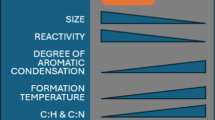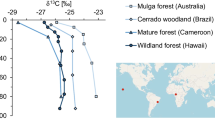Abstract
Chemical and optical characteristics of soil humus have been analyzed as “memory” components of the Pleistocene volcanic paleosols in Mexico. We have studied the A1 horizons of buried Andosols of the Nevado de Toluca series and of the modern Andosols formed under different bioclimatic conditions. Data on the organic matter of buried paleosols suggest that Andosols of the Nevado de Toluca series were formed in humid forest ecosystems. Optical characteristics of the humic acids and data on the molecular-mass distribution of the humus make it possible to assume that these soils were formed under pine forests rather than under fir forests.
Similar content being viewed by others
References
O. N. Biryukova and D. S. Orlov, “Composition and Properties of Organic Matter in Buried Soils and Fossil Sediments,” Pochvovedenie, No. 9, 49–66 (1980).
A. N. Gennadiev, Soils and the Time: Models of Development (Mosk. Gos. Univ., Moscow, 1990) [in Russian].
M. I. Dergacheva, Archeological Soil Science (Ross. Akad. Nauk, Novosibirsk, 1997) [in Russian].
M. I. Dergacheva, “Humus as a Memory of Ecosystems,” in Functions of Soils in Biospheric-Geospheric Systems: Proceedings of the International Symposium, Moscow, Russia, 2001 (MAKS Press, Moscow, 2001), pp. 270–271 [in Russian].
H. Determan, Gelchromatographie, West Berlin, 1967.
N. S. Drozdova, V. A. Terekhova, E. P. Zazovskaya, and S. Ya. Trofimov, “Decomposition of Organic Matter in Soils of Old Russian Settlements under Introduction of Micromycetes,” Vestn. Mosk. Univ., Ser. 17: Pochvoved., No. 4, 39–44 (2001).
Organic Matter of Fossil Soils: Proceedings of the Institute of Geology and Geophysics, Ed. by S. A. Arkhipov, I. M. Gadzhiev, M. I. Dergacheva, and V. S. Zykina (Nauka, Moscow, 1988), No. 702 [in Russian].
D. S. Orlov, Soil Humus Acids and the General Theory of Humification (Mosk. Gos. Univ., Moscow, 1990) [in Russian].
D. S. Orlov, O. N. Biryukova, and N. I. Sukhanova, Organic Matter of Soils of the Russian Federation (Nauka, Moscow, 1996) [in Russian].
S. N. Sedov, E. Solleiro-Rebolledo, Kh. E. Gama-Kastro, et al., “Buried Andosols of the Tuluca Volcano and Late-Quaternary Evolution of Landscapes in Central Mexico,” Vestn. Mosk. Univ., Ser. 17: Pochvoved., No. 4, 3–8 (2000).
E. Solleiro-Robolledo, Kh. E. Gama-Kastro, S. Palasios-Maiorga, et al., “Late Pleistocene Paleosols in Central Mexico: Genesis and Paleogeographic Interpretation,” Pochvovedenie, No. 10, 1205–1212 (1999) [Eur. Soil Sci. 32 (10), 1077–1083 (1999)].
S. Ya. Trofimov, O. S. Yakimenko, S. N. Sedov, et al., “Composition and Properties of Organic Matter in the Soils of Ancient Slavic Settlements in the Forest Zone,” Pochvovedenie, No. 9, 1057–1066 (2004) [Eur. Soil Sci. 37 (9), 927–936 (2004)].
O. S. Yakimenko and S. Ya. Trofimov, “Soil Humus Status of an Archeological Complex,” in Humic Substances in the Biosphere: Proceedings of the 2nd International Conference, Moscow, Russia, 2003 (Moscow, 2004), pp. 140–144 [in Russian].
A. Bronger, R. Winter, and T. Heinkele, “Pleistocene Climatic History of East and Central Asia Based on Paleopedological Indicators in Loess-Paleosol Sequences,” Catena, No. 34, 1–17 (1998).
D. Dubroeucq, D. Geissert, and P. Quantin, “Weathering and Soil Forming Processes under Semiarid Conditions in Two Mexican Volcanic Ash Soils,” Geoderma, No. 86, 99–122 (1998).
H. Foelster, W. Hetsch, and E. Schrimpff, “Late Quaternary Paleosols in the Western and Central Cordillera of Colombia,” Palaeogeogr. Palaeoclimatol. Palaeoecol., No. 21, 245–264 (1977).
O. Iakimenko and S. Trofimov, “Humic Acids of Anthropogenically Transformed Soils of Ancient Settlement,” in Humic Substances and Soil and Water Environment: Proceedings of the XII International Meeting of the International Humic Substances Society, Sao Pedro, Sao Paulo, Brazil, 2004 (2004), pp. 161–164.
C. Jasso-Castaneda, S. Sedov, E. Solleiro-Rebolledo, and J. Gama-Castro, “El desarrollo de paleosuelos como indice de estabilidad del paisaje,” Investigaciones Geograficas, Boletin del Instituto de Geografia, UNAM, No. 47, 20–35 (2002).
S. Lozano-Garcia, B. Ortega-Guerrero, M. Caballero-Miranda, and J. Urrutia-Fucugauchi, “Late Pleistocene and Holocene Paleoenvironments of Chalco Lake, Central Mexico,” Quat. Res., No. 40, 332–342 (1993).
S. Lozano-Garcia and B. Ortega-Guerrero, “Palynological and Magnetic Susceptibility Records of Lake Chalco, Central Mexico,” Palaeogeogr. Palaeoclimatol. Palaeoecol., No. 109, 177–191 (1994).
G. Miehlich, Chronosequences of Volcanic Ash Soils: Hamburger Bodenkundliche Arbeiten 15 (Hamburg, 1991).
B. Ortega-Guerrero, R. Thompson, and J. Fucugauch Urrutia, “Magnetic Properties of Lake Sediments from Lake Chalco, Central Mexico, and Their Palaeoenvironmental Implications,” J. Quat. Sci., No. 15, 127–140 (2000).
E.-M. Schmid, J. O. Skjemstad, B. Glaser, et al., “Detection of Charred Organic Matter in Soils from Neolithic Settlement in Southern Bavaria, Germany,” Geoderma, No. 107, 71–91 (2002).
S. N. Sedov, E. P. Zazovskaya, M. A. Bronnikova, et al., “Late Holocene Man-Induced Environmental Change in Central Russian Plain: Paleopedological Evidences from Early Medieval Archaeological Site,” Climatic Change: Paleopedological and Soil Rock Magnetic Approaches: Chinese Science Bulletin 44 (1999).
S. Sedov, E. Solleiro-Rebolledo, J. E. Gama-Castro, et al., “Buried Palaeosols of the Nevado de Toluca: An Alternative Record of Late Quaternary Environmental Change in Central Mexico,” J. Quat. Sci. 16(4), 375–389 (2001).
S. Sedov, E. Solleiro-Rebolledo, P. Morales-Puente, et al., “Mineral and Organic Components of the Buried Paleosols of the Nevado de Toluca/Central Mexico as Indicators of Paleoenvironments and Soil Evolution,” Quat. Int., Nos. 106–107, 169–184 (2003).
S. Shoji, M. Nanzyo, and R. Dahlgren, “Volcanic Ash Soils: Genesis, Properties, and Utilization,” in Developments in Soil Science (Elsevier, Amsterdam, 1993), Vol. 21.
E. Solleiro-Rebolledo, J. L. Macias, S. Gama-Castro, and S. Sedov, “Quaternary Pedostratigraphy of the Nevado de Toluca Volcano,” Revista Mexicana de Ciencias Geologicas, 21(1), 101–109 (2004).
M. Watanabe, H. Tanaka, K. Sakagami, et al., “Evaluation of Pg Absorption Strength of Humic Acids as a Paleoenvironmental Indicator in Buried Paleosols on Tephra Beds, Japan,” Quat. Int., Nos. 34–36, 197–203 (1996).
Author information
Authors and Affiliations
Additional information
Original Russian Text © O.S. Yakimenko, S.N. Sedov, E. Solleiro, 2007, published in Pochvovedenie, 2007, No. 3, pp. 302–309.
Rights and permissions
About this article
Cite this article
Yakimenko, O.S., Sedov, S.N. & Solleiro, E. The humus status of modern and buried volcanic soils in Mexico and its role in the paleogeographic interpretation of tephra-paleosol sequences. Eurasian Soil Sc. 40, 274–280 (2007). https://doi.org/10.1134/S1064229307030052
Received:
Issue Date:
DOI: https://doi.org/10.1134/S1064229307030052




